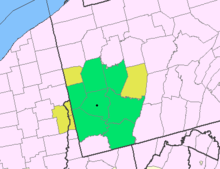University of Pittsburgh Applied Research Center
[12][13] In 1985 Gulf Oil was acquired by Chevron Corporation which maintained its own research facilities in Richmond, California, the complex had grown to 85 acres (340,000 m2) with 54 multi-story lab buildings and employed nearly 2,000 scientists and engineers with an annual operation budget of over $100 million.
Gulf and Chevron agreed to the university's proposal and donated the site, valued at $100 million including the fully furnished and equipped laboratories, a computer telecommunications center, an executive office building, and unique facilities such as large cold room containing a wind tunnel.
[19] On March 17, 1986, the university signed its first major tenant, General Motors Corporation, to a four-year, $13 million contract[19] and in two years was sheltering 80 small businesses.
Postal Service sub-station, a credit union, ATMs, picnic areas, outdoor dining, volleyball courts, locker rooms, and shower facilities.
[21] In addition to the companies that occupied the facilities at U-PARC, the University of Pittsburgh's Swanson School of Engineering maintained research groups and laboratories at the site, including the Manufacturing Assistance Center.
The center comprises a synergistic network of laboratories encompassing machine tooling, computer-aided design and manufacturing, metrology, materials tracking, and human issues.
[24] In response a concept of shared manufacturing was created by Pitt School of Engineering professors Dr. Bopaya Bidanda and Dr. David I. Cleland, and a proposal describing how the MAC would meet this need resulted in a $2.3 million grant from the Economic Development Administration of the U.S. Department of Commerce.
Working in partnership with private industry, the MAC is part of the development of the regional RoboCorridor, promoting automation and agile robotics.
There are five additional rooms available on the basement floor for offices, storage, a small production setup area, along with a test facility with a garage entrance and access to a 1-ton overhead crane.


